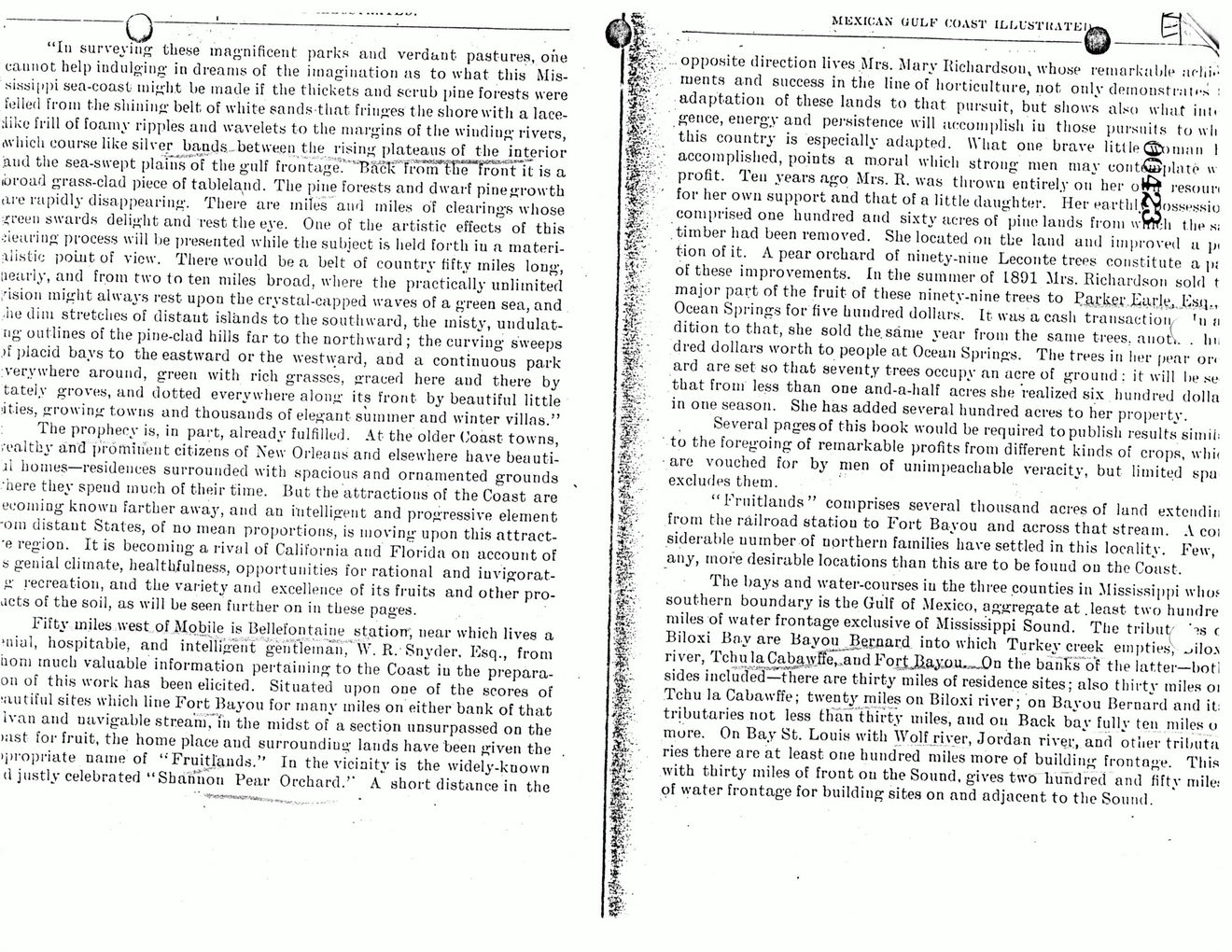This text was obtained via automated optical character recognition.
It has not been edited and may therefore contain several errors.
“In surveying1 these magnificent parks and verdant pastures, one cannot help indulging in dreams of the imagination as to what this Mississippi sea-coast might be made if the thickets and scrub [line forests were felled from the shining belt, of white sands that fringes the shore with a lace-:like frill of foamy ripples and wavelets to the margins of the winding rivers, (Which course like silver bands,..between the rising plateaus of the interior And the sea-swept plains of tlie gulf frontage”>'"Bacir FrcMirffteHTont it is a ibroad grass-clad piece of tableland. The pine forests and dwarf pinegrowth are rapidly disappearing. There are miles and miles of clearings whose greenswards delight and rest the eye. One of the artistic effects of this •bearing process will lie presented while the subject is held forth iu a materialistic point of view. There would be a belt of country fifty miles long, nearly, and from two to ten miles broad, where the practically unlimited /ision might always rest upon the crystal-capped waves of a green sea, and he dim stretches of distant islands to the southward, the misty, undulating outlines of the pine-clad hills far to the northward ; the curving sweeps >f placid bays to the eastward or the westward, and a continuous park vervwhere around, green with rich grasses, graced here and there by tately groves, and dotted everywhere along its front by beautiful little ?ities, growing towns and thousands of elegant summer and winter villas.” The prophecy is, in part, already fulfilled. At the older (’oast towns, veal thy and prominent citizens of New Orleans and elsewhere have beauti-ji homes—residences surrounded with spacious and ornamented grounds here they spend much of their time. But the attractions of the Coast are ecoming known farther away, and an intelligent and progressive element •oin distant States, of no mean proportions, is moving upon this attract-•e region. It is becoming a rival of California and Florida on account of s genial climate, healthfulness, opportunities for rational and iuvigorat-g recreation, and the variety and excellence of its fruits and other pro-acts of the soil, as will be seen further on in these pages. Fifty miles west of Mobile is Bellefontaine station, near which lives a niiul, hospitable, and intelligent gentleman, \V. R. Snyder. Esq., from iiom much valuable information pertaining to the Coast iu the prepara-on of this work has been elicited. Situated upon one of the scores of ■autiful sites which line Fort Bayou for many miles on either bank of that Ivan and uavigable stream, in the midst of a section unsurpassed on the iast for fruit, the home place and surroundiug lands have been given the ipropriate name of Fruitlands.” In the vicinity is the widely-kuown d justly celebrated “ Shannon Pear Orchard.’’ A short distance in the opposite direction lives Mrs. Mary Richardson* whose remarkable ar-lii.'. merits and success in the line of horticulture, not only demonstrates t adaptation of these lands to that pursuit, but shows also what int> gence, energy and persistence will accomplish iu those pursuits to wli this country is especially adapted. What one brave little ©um;in 1 ■ accomplished, points a moral which strong men may con ti©| ilato w profit. Ten years ago Mrs. R. was thrown entirely on her o^J resoun for her own support and that of a little daughter. Her earthl vQossessio comprised one hundred and sixty acres of pine lands from wm?;h tlie s; timber had been removed. She located on the land and improved a pi tion of it. A pear orchard of ninety-nine Leconte trees constitute a pi of these improvements. In the summer of 1891 Mrs. Richardson sold t major part of the fruit of these ninety-nine trees to Pailiev Earle,, ICsij., Ocean Springs for five hundred dollars. It was a cash transaction, 'n n dition to that, she sold the.same year from the same trees, anon. . hi. dred dollars worth to people at Ocean Springs. The trees in her pear on ard are set so that seventy trees occupy an acre of ground : it will lie se that from less than one and-a-half acres she realized six hundred dolla in one season. She has added several hundred acres to her property. Several pages of this book would be required to publish results simili to the foregoing of remarkable profits from different kinds of crops, whi< are vouched for by men of unimpeachable veracity, but limited spa excludes them. “Fruitlands” comprises several thousand acres of land extcndin from the railroad statiou to Fort Bayou and across that stream. A coi siderable number of uprthern families have settled in this locality. Few, any, more desirable locations than this are to be fouud on the Coast. The bays and water-courses iu the three counties in Mississippi who.1 southern boundary is the Gulf of Mexico, aggregate at .least two hundre miles of water frontage exclusive of Mississippi Sound. The tribut' c Biloxi Bay are Bayou^Bqrnard into which Turkey creek empties, ~>iIo> river, Tchu 1 aCab^yvfite,>and FortJlayon the bants olf the latter—botl sides included—there are thirty miles of residence sites; also thirty miles oi Tchu la Cabawffe; twenty miles on Biloxi river; on Bayou Bernard and it: tributaries not less than thirty miles, and on Back bay fully ten miles o more. On Bay St. Louis with Wolf rive1’. Jordan river, and other tributa ries there are at least, one hundred miles more of building frontage. This with thirty miles of front on the Sound, gives two hundred and fifty mile: of water frontage for building sites on and adjacent to the Sound.

Coast General Mexican-Gulf-Coast-Illustrated-1893-(05)